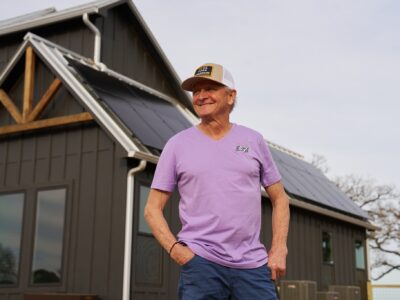In Chester County, Pennsylvania, there are three acres of stream-side land brim, with a variety of flower and fruit-bearing trees such as American persimmons, red-twig dogwoods and willows.
The land happens to sit at the intersection of two tributaries, Beaver Run and French Creek. Entrepreneurial farmer Austin Unruh chose this patch of land to employ a new farming technique that can cut down on water pollution and enhance the surrounding landscape. Called a “working buffer,” this innovative practice transforms land bordering rivers and streams into terrain that’s both money-making and good for the environment.
The Problem
Over the years, many water-adjacent forests have been cut down to build cities and towns or to use as farmland. But these forests have traditionally served as buffer zones to filter out pollutants and protect against flooding. Without them, stormwater picks up pesticides, fertilizers and other pollutants and distributes them into our rivers and streams.
The Environmental Protection Agency (EPA) reports that 100,000 miles of rivers and streams have poor water quality due to phosphorus and nitrogen pollution (both of which can be found in chemical fertilizers, wastewater and fossil fuels). According to the EPA, these pollutants have “far-reaching impacts on public health and the environment.” Nitrogen in drinking water can be harmful, even at low levels, and it also negatively affects soil and forests.
The Solution
Replanting native trees and shrubs along streams creates what’s called a riparian forest buffer, similar to what Unruh created along Beaver Run and French Creek. These buffers not only inhibit pollutants from entering rivers and streams, but they also provide food for wildlife, nesting sites for birds and shade for waterways.
Historically, farmers have been reluctant to siphon off valuable, income-producing farmland near riverbanks to plant a forest. But a Pennsylvania grant program seeks to remove that obstacle. The grant program incentivizes landowners to create buffer zones that will also yield cash crops, hence the name “working buffer.” The state has an ambitious goal of planting 85,650 acres of new forests by 2025.
According to leaders of the grant program, buffers are divided into three zones. The first zone, which can be as narrow as 15 feet, is meant to stabilize the waterfront. In the second zone, farmers plant trees and shrubs that can withstand occasional flooding such as black walnut, American hazelnut and common elderberry. Although only hand-harvesting is allowed in this zone, it can still yield income-generating fruits and nuts. The last zone is devoted primarily to commercial harvesting and can includes flowering trees in addition to fruit and nut trees. Other options for income-producing crops include beehives for honey or medicinal plants like ginseng and black cohosh.
Grant program participants are poised to make a difference not only in their local communities but in the Northeast region at large. Many Pennsylvania tributaries eventually run into the Delaware River, which extends from the Catskill Mountains in New York into the Atlantic Ocean. The Delaware River supplies drinking water to millions of people across the region and supports a multitude of orchards and farms.
Challenges for the Future
As a farming technique, working buffers overlap with a larger movement called agroforestry, which the USDA defines as “the intentional integration of trees and shrubs into crop and animal farming systems to create environmental, economic and social benefits.” With this philosophy in mind, Unruh started his own non-profit, Crow and Berry Land Management, to help farmers integrate tree systems that serve their current crops and create new ones.
But some of these innovative methods, including working buffers, are not yet widespread practices. Farmers may be uncertain of how to market working buffer crops or how to maintain buffer zones over the long-term.
Organizations are working to address these concerns. For example, the Pennsylvania Infrastructure Investment Program tracks the start-up and maintenance costs, as well as the income, of working buffers. Propagate Ventures aims to “identify opportunities for agroforestry systems, based on short and long-term goals,” and matches farmers with ecologically-minded investors.
It may take some time for working buffers to become a widely adopted practice, in the meantime, zones like the one near Beaver Run and French Creek continue to enhance the natural environment while also turning a profit. A win, win.





